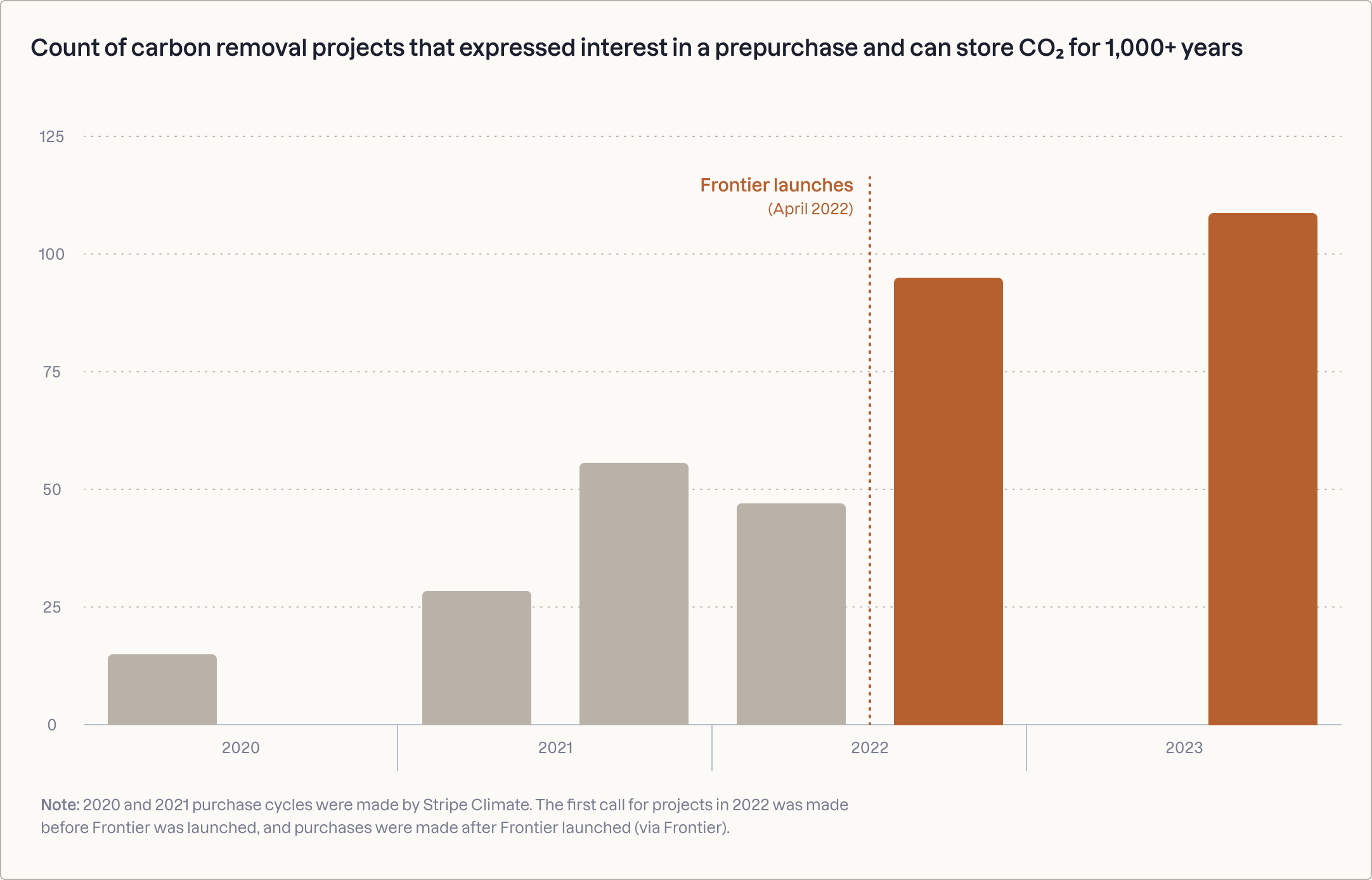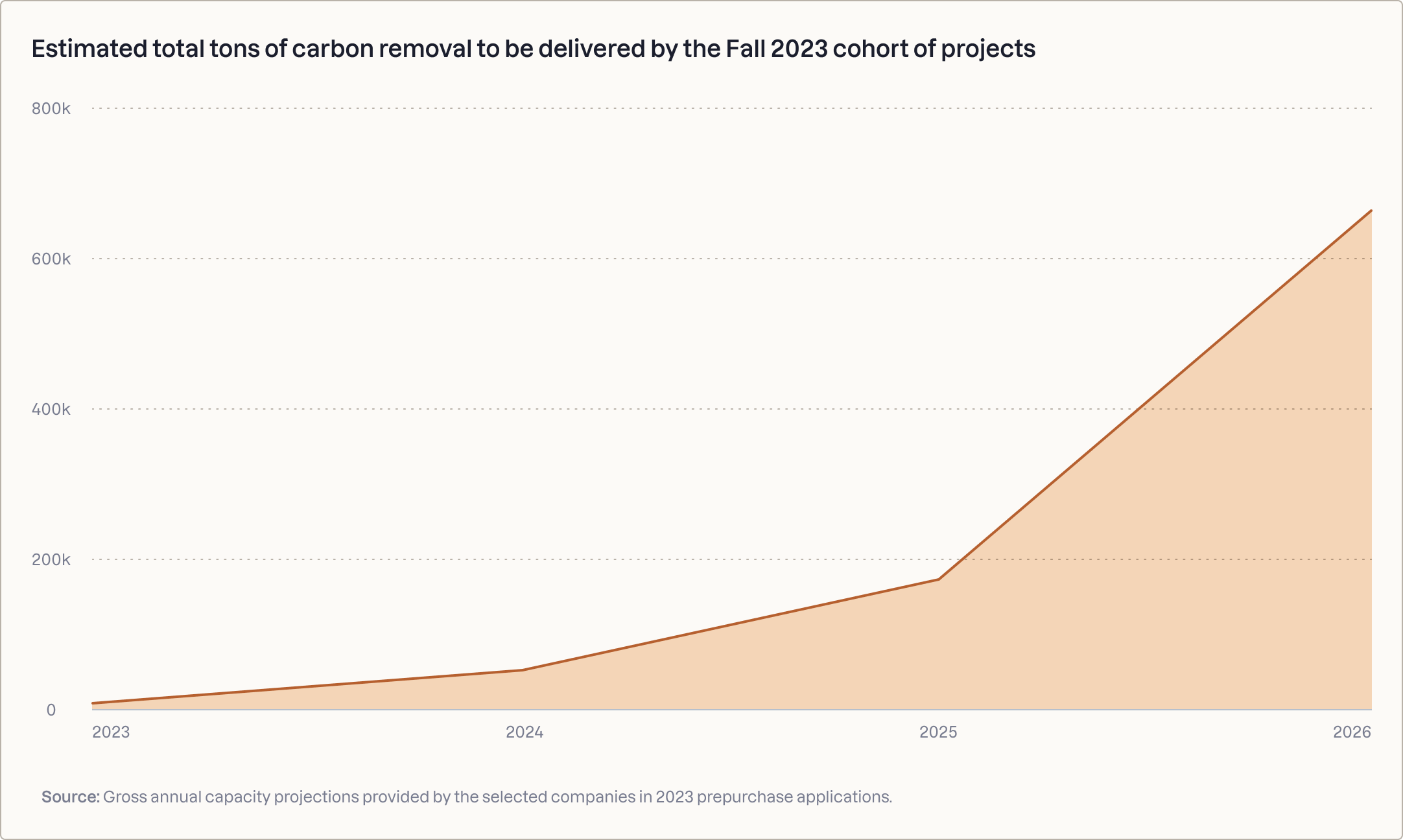Frontier facilitates third round of carbon removal purchases
September 7, 2023
September 7, 2023
Frontier has facilitated $7M of carbon removal purchases from 12 companies—Airhive, Alkali Earth, Banyu Carbon, Carbon Atlantis, CarbonBlue, CarbonRun, EDAC Labs, Holocene, Mati, Planetary Technologies, Spiritus Technologies, and Vaulted Deep—on behalf of buyers Stripe, Shopify, and H&M Group. In addition, Stripe has provided $500K in R&D grants to Carboniferous and Rewind, and $200K to Arbon and Vycarb as part of a partnership with Activate.
Over the last three months, the Frontier team evaluated 132 applications along with 230 pages of technical reviews on selected applications from Frontier’s global network of scientific experts. This cycle we saw a more than 7X increase in applications proposing solutions that can store CO₂ for 1,000+ years compared to Stripe’s first purchase cycle three years ago.

The companies selected are pursuing 14 distinct approaches to carbon removal. These include a photo-excitable molecule to extract CO₂ from seawater, a slurry sequestration technology that lowers the costs of biomass injection, and enhancing the carbon absorption capacity of rivers with minerals. Collectively, they address all five of the priority innovation areas identified in Frontier’s RFP, including reducing the energy and cost of direct air capture and accelerating weathering rates of geochemical approaches.
This is Frontier’s most geographically diverse cohort of companies to date, with headquarters in five different countries. Deployment sites include rice paddy farms in central India, gravel roads in northern Indiana, watersheds in Nova Scotia, and a desalination plant on the Mediterranean coast of Israel. Based on their own projections, the selected companies could collectively remove more than half a million tons of CO₂ annually by 2026.

Direct air capture | London, UK | 943 tons
Airhive is building a geochemical direct air capture system using a sorbent that can be made out of cheap and abundant minerals. This sorbent reacts rapidly with atmospheric CO₂ when mixed with air in Airhive’s fluidized bed reactor. Coupled with a regeneration process that’s powered by electricity to release the CO₂ for geologic storage, this provides a promising approach to low-cost DAC.
Mineralization | Northfield, MN, US | 1,351 tons
Alkali Earth uses alkaline byproducts from industrial processes as carbon-removing gravel to apply to roads. These minerals act as a sink for atmospheric CO₂, storing it permanently while cementing road surfaces. The formation of CO₂-containing minerals within the gravel can be directly measured, leading to high-confidence in resulting removals.
Direct ocean removal | Seattle, WA, US | 360 tons
Banyu uses sunlight to capture CO₂ from seawater. A reusable, light-activated molecule that becomes acidic when exposed to light causes carbon dissolved in seawater to degas as CO₂, which is then stored permanently. Because only a small portion of the visible light spectrum is needed to trigger the reaction, this is a highly energy-efficient approach to direct ocean removal.
Direct air capture | Munich, Germany | 47,276 tons
Phlair uses a process known as electrochemical pH-swing. Their system uses a solvent to capture CO₂ and an acid to release it. Their cell architecture is designed for industrial-sized stacks, and the components of this modular system are readily available and industry-proven, making the process cost-effective and energy-efficient. Captured CO₂ is stored underground via geologic sequestration.
Direct ocean removal | Haifa, Israel | 400 tons
CarbonBlue uses calcium in a closed-loop cycle to mineralize, separate, and remove dissolved CO₂ from water. This results in a pure stream of CO₂ that can be durably sequestered. Their approach can operate in freshwater or saltwater and can rely on waste heat for the regeneration process. The team plans to integrate with desalination plants and other water-withdrawing industries, reducing energy usage and costs.
Ocean alkalinity enhancement | Halifax, Nova Scotia, CA | 56,753 tons
CarbonRun adds crushed limestone to rivers to raise their pH, storing CO₂ as dissolved bicarbonate in the river and ultimately in the ocean. In addition to CO₂ removal, CarbonRun’s work also benefits river ecosystems locally by increasing the pH.
Mineralization | Baltimore, MD, US | 317 tons
EDAC Labs uses an electrochemical process to produce acid and base. The acid is used to start the recovery of valuable metals from mining waste, and the base is used to capture CO₂ from air. The acid and base streams are then combined to produce metals that can be sold for applications such as batteries, and solid carbonates, which permanently store CO₂.
Direct air capture | Knoxville, TN, US | 332 tons
Holocene captures CO₂ from air using organic molecules that can be produced at low cost. In the first step of their process, CO₂ is captured from air when it comes into contact with a liquid solution. In the second step, a chemical reaction crystallizes the material as a solid. That solid is heated up to release the CO₂, minimizing energy wasted in heating water. Holocene’s process runs at lower temperatures, further reducing the energy required, increasing energy flexibility, and lowering overall cost.
Field weathering | Houston, TX, US | 1,513 tons
Mati applies silicate rock powders to agricultural fields, starting with rice paddy farms in India. These rocks react with water and CO₂ to produce dissolved inorganic carbon that is subsequently stored in the local watershed and eventually in the ocean. Mati relies on rice field flooding and higher subtropical temperatures to accelerate weathering, and extensive sampling and soil and river modeling to measure removal and deliver co-benefits to smallholder farmers.
Ocean alkalinity enhancement | Halifax, Nova Scotia, CA | 116,972 tons
Planetary adds alkaline minerals to coastal surface waters to capture CO₂. With this offtake, Planetary is expanding on the pilot project that delivered the world’s first verified ocean alkalinity enhancement tons, and initiating the next phase of operation with deliveries starting in 2026.
Direct air capture | Los Alamos, NM, US | 713 tons
Spiritus uses a sorbent made from commercially-available materials and a passive air contactor that requires little energy to capture CO₂. The CO₂-saturated sorbent is then regenerated using a novel desorption process, capturing the CO₂ and allowing the sorbent to be reused with less energy than a higher-heat vacuum chamber typically used in direct air capture approaches. The high-performance, inexpensive sorbent and lower regeneration energy provide a path to low cost.
Biomass carbon removal & storage | Houston, TX, US | 154,146 tons
Vaulted injects carbon-rich organic waste biomass deep underground for permanent storage. This disposal method also replaces harmful disposal practices like land application and incineration. As a spinoff from an established waste disposal company, Vaulted benefits from already-permitted well infrastructure, and a team with longstanding operational experience.
Direct air capture | New York, NY, US | 173 tons
Arbon uses a 'humidity-swing' process to capture CO₂ from the air. The sorbent binds CO₂ when dry and releases it when wet. This process uses less energy than approaches that rely on changing temperature and pressure to release CO₂. The sorbent’s ability to bind CO₂ has been shown to remain stable over thousands of cycles. Both of these innovations could reduce the cost of DAC.
Ocean alkalinity enhancement | Brooklyn, NY, US | 58 tons
Vycarb uses a reactor to add limestone alkalinity to coastal ocean water, resulting in the drawdown and storage of atmospheric CO₂. Their dissolution system has a novel sensing apparatus that base tests water, dissolves calcium carbonate, and doses alkalinity into the water at a controlled amount safe for dispersion. Their closed system makes it easier to measure the amount of dissolved alkalinity added and CO₂ removed.
Biomass carbon removal & storage | Houston, TX, US | 0 tons
Carboniferous sinks bundles of leftover sugarcane fiber and corn stover into deep, salty, oxygenless basins in the Gulf of Mexico. The lack of oxygen in these environments–and therefore absence of animals and most microbes–slows the breakdown of biomass so it is efficiently preserved and stored durably in ocean sediments. The team will conduct experiments to determine the functional stability of sunken biomass as well as the interaction with ocean biogeochemistry.
Biomass carbon removal & storage | Tel Aviv, Israel | 0 tons
Rewind uses cranes off of boats to sink agricultural and forest residues to the oxygenless bottom of the Black Sea, the largest anoxic body of water on Earth. Oxygenless water dramatically slows biomass decomposition. The lack of living organisms in the Black Sea limits any potential ecosystem risks. This process allows for affordable and environmentally safe carbon removal.
Frontier is an advance market commitment to buy an initial $1B of carbon removal by 2030. It was founded by Stripe, Alphabet, Shopify, Meta, and McKinsey Sustainability.
If you are a carbon removal supplier, we’d love to hear from you. You can find more details about Frontier’s purchase process here.
If you are interested in becoming a buyer of carbon removal through Frontier, please get in touch at buyers@frontierclimate.com.